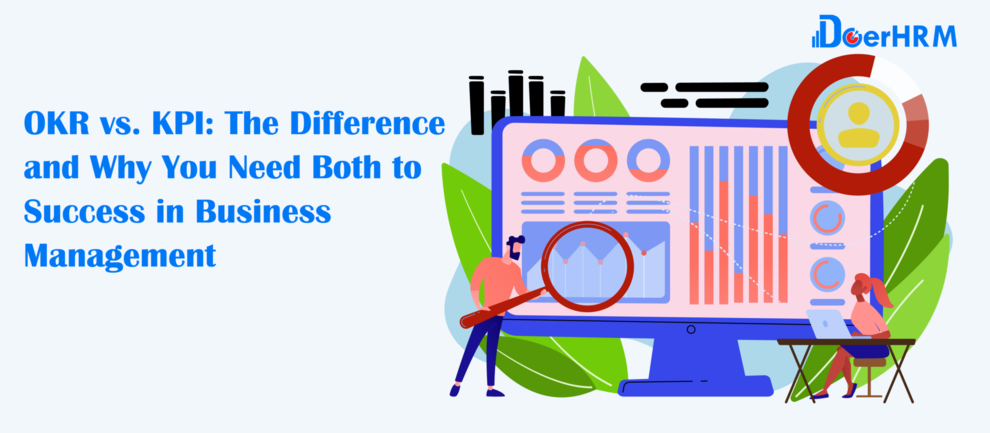When leading a team, you need to ascertain your metrics for success to enable you to reflect periodically and ensure that you’ve met specific goals and targets outlined at the beginning of the year. To successfully manage your business, you need to review your overall performance and resolve to fix things that didn’t go so well. This post will explore both OKRs and KPIs and argue why you need to utilize both to succeed in business.
What does OKR & KPI stand for?
Depending upon the sector that you work in, you may be more familiar with one acronym over another. OKR stands for Objectives and Key Results, while KPI stands for Key Performance Indicators. They are both commonly used to establish and plan quarter or annual goals within a business.
OKR is an objective tied to key results. And, OKR is a strategic framework, whereas KPIs are measurements that exist within a framework.
Before understanding why they are both critical for your business, let’s first look at them in isolation.
What does OKR & KPI stand for?
Depending upon the sector that you work in, you may be more familiar with one acronym over another. OKR stands for Objectives and Key Results, while KPI stands for Key Performance Indicators. They are both commonly used to establish and plan quarter or annual goals within a business.
OKR is an objective tied to key results. And, OKR is a strategic framework, whereas KPIs are measurements that exist within a framework.
Before understanding why they are both critical for your business, let’s first look at them in isolation.
Objectives and Key Results (OKR)
OKRs are metrics that outline company and team objectives and articulate vital results that must be attained to support the business’ growth. OKRs are often overly ambitious goals created to drive a business’ success, and within the goals, measurable steps are defined to chart the course toward attaining a particular goal. OKRs are most commonly utilized by high-performing businesses to plan quarterly goals, and they originate from large tech companies such as Intel and Google.
Key Performance Indicators (KPI)
KPIs are performance metrics that evaluate the success of an organization holistically. They can also be used to measure the outcome of a particular focused activity. Within businesses, KPIs are attached to much of the work carried out, including individual projects, product launches, and various other critical elements of a business. KPIs are also used to measure the success and achievements of everything from sales targets to social media and marketing metrics. While KPIs are widely prevalent across organizations, they are only useful if they are personalized and specific to the team and business in question. Many companies assume that they can take KPIs from other successful organizations and replicate them within their own work; however, this seldom works.
What are the differences between OKRs and KPIs?
After defining both OKRs and KPIs in isolation, you would be forgiven for thinking they appear, on the surface, to be very similar. And as has been mentioned, they are both powerful tools for effective business planning and ensuring that the teams within your business stay motivated to achieve the outcomes and targets set for them. However, it’s vitally important to acknowledge that OKRs and KPIs are not the same things. For your company to be successful, you should utilize both in the management of your business.
One of the fundamental differences between OKRs and KPIs is the intention behind the goal setting. The vast majority of OKRs are highly ambitious and a little out there. In contrast, KPIs are more typically obtainable and represent the output of a project that is already in place. That being said, OKRs should not be totally unrealistic or unfeasible. For example:
An OKR could be to become the leading marketing leader in our industry
Objective: Become the market leader in our industry.
Key Result #1: Record $120 million in revenue.
Key Result #2: Increase profitability by 35 percent.
Key Result #3: Increase market cap sufficiently to enter S&P 500.
A KPI, therefore, could be to achieve $120 million annual revenue in this year, and when we break it down monthly, it become monthly revenue KPI to achieve $10 million.
Yes, sometimes an organization’s KPIs are the same as the key results used in an OKR framework
While the OKR in this example is incredibly ambitious, it isn’t totally unfeasible. The KPIs then employed by this company to help teams within the organization work towards achieving success for the business as stipulated in the OKRs. OKRs are an excellent way to increase employee motivation and keep them focused and dedicated to achieving the targets and goals that have been set.
In order to define the difference between an OKR and a KPI, you could say that the OKR is the ultimate goal of your company, and the KPI measures the success, output, quantity/quality, and ongoing process of an activity or project that helps you work toward this overarching goal.
Why do you need both OKRs and KPIs to be successful?
Because OKRs and KPIs complement one another, you need to plan them both into your business strategy in order to be successful. Utilizing both ensures that you have a clear, ambitious plan for your company’s future while being realistic about how you can achieve the goals you articulate. Many successful companies use KPIs to monitor their monthly and quarterly progress on a micro level, whereas OKRs are used to communicate their broader strategy.
Indeed, to comprehensively manage goal setting within your business, you should use both concepts in a coordinated manner. For example, if you are falling behind on a particular KPI target, an OKR is needed to put everything back on track. Furthermore, if you want to achieve a more ambitious KPI target, you need to establish OKRs that will help guide you in line with the company’s goals and objectives. Complementary KPIs and OKRs should be sewn into all successful companies’ fabric, as they allow organizations to plan, thrive, and grow.
Conclusion: The importance of measuring performance
Whatever you do within your business, you must measure your performance if you are to improve and succeed. Suppose you don’t articulate an achievable, aggressive OKR that your employees can buy into. In that case, you risk lacking motivation and develop a situation whereby a large proportion of your staff are underperforming. Moreover, if teams within your company are not working towards SMART KPIs, then they have no way of monitoring their quarterly success in helping the company grow. Managers and company directors must work to delineate the differences between OKRs and KPIs and articulate them widely throughout the company, so all staff members understand what is expected of them.
To learn how OKRs can help take your team to the next level, enroll in our OKR Mastery course and earn a 35% commission when you invite others to join this course!






